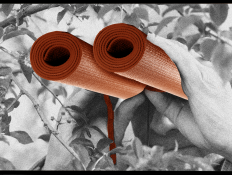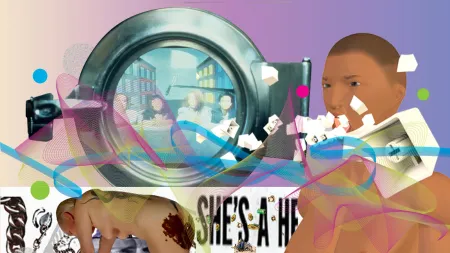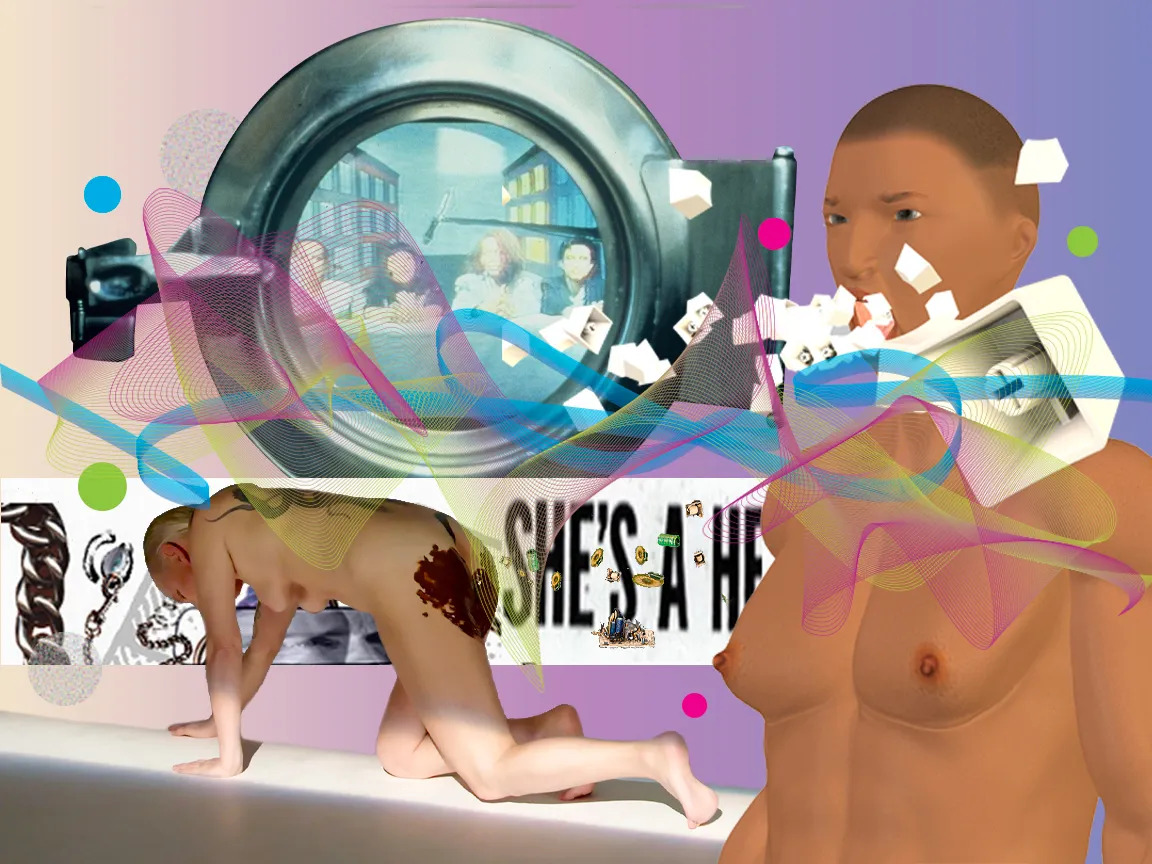
Even though it looks nothing like her, Shu Lea Cheang is fond of calling the gray-skinned being in her 2023 video UTTER her “AI self-portrait.” This figure changes constantly, sprouting breasts that morph into muscular pecs, flitting between races, and shifting age so that it appears variously like an elderly man, a young woman, or something in between. “If it were possible to make an AI for myself,” she explained, “I would like all these moving possibilities.”
UTTER is Cheang’s response to the limits of AI alignment, a process that aims to guide programmed systems toward human goals. No matter how much data it digests, AI still stumbles when it comes to understanding the race, gender, and sexuality of its users. To put it another way, AI, like most things in our world, was designed to meet the needs of straight white men. The artist Stephanie Dinkins, whose work has focused on AI’s problematic relationship to Blackness, has spoken of how such “biases are embedded deep in these systems,” to a point where it all becomes “ingrained and automatic.”
Notably, in creating UTTER Cheang did not utilize AI—a fact that she attributed to funding constraints. Instead she relied on computer coding parameters, which she used to control the figure’s race and gender. A related video, titled PARAMETERS, offers a behind-the-scenes glimpse as certain parameters are removed and then added back in. These are represented as sliders that move up and down—almost as though tracks were being mixed by a DJ on a controller—creating shifts in bodily appearance that are both grotesque and hypnotic.
The figure isn’t all that morphs. At UTTER’s start, the figure holds a pacifier in its mouth. The pacifier gradually transforms into a ball gag, a device often worn by submissive partners during S&M sex. Ultimately the gag flies out of the figure’s mouth, which then vomits a spray of keyboard keys.
This piece, which debuted last year at Norway’s Kunsthall Trondheim, underlines Cheang’s interest in how one’s identity alters one’s experience of technology, and vice versa. Speaking by Zoom from her Paris apartment, she told me the figure’s identity was a reflection of her own: “I refuse to be set in one color, in terms of racial representation, or to be set in one sexuality, in terms of gender representation.”
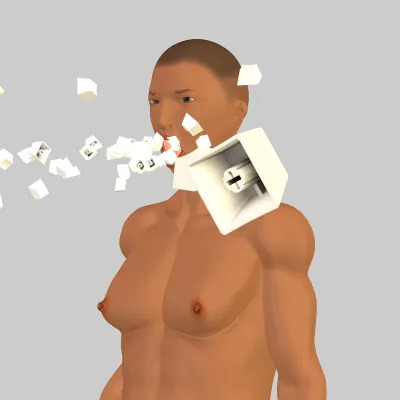
Cheang described how, as a queer woman born in Taiwan and now based abroad, she has experienced many attempts to box her in. “I tend not to be confined to a very set race and gender,” she said. “People say, ‘Oh, you are Asian, you are Taiwanese.’ They want to be able to label me with one nationality. And then they get confused between lesbian or queer or nonbinary. Recently people have tried to define me as nonbinary,” she continued, laughing. “I’ve said, ‘Okay, fine, whatever!’”
Professionally as well as personally, Cheang, 70, has reveled in the pleasure of being indefinable for more than three decades. She has produced an array of videos, films, installations, and internet artworks that take aim at a wide range of technologies, from surveillance systems to bioengineering. She has directed pornographic sci-fi movies meant for theaters, crafted punkish installations intended for galleries, and even devised pieces for the internet about bowling alleys and queer history.
“She’s thinking about her own experience of life, looking at these technologies,” said Sarah Johanna Theurer, the curator of a Cheang survey due to open at Munich’s Haus der Kunst next year. “She’s someone who actually manages to connect the internet to, say, political history or the social agency that you have, rather than just making work about the medium.”
Although Cheang’s art gained her accolades in the 1990s, her work became the stuff of cult fandom in the following years. Now her audience is growing once more. This year she won the Guggenheim Foundation’s $100,000 award for achievement in technology-based art. Meanwhile, Fresh Kill, her Staten Island–set 1994 feature film about hackers confronting a capitalist cabal, was restored after years of obscurity. Next year will bring Cheang even more attention: She is set to have her biggest museum survey to date at the Haus der Kunst in February before debuting a performance-art piece making use of motion-capture technology at Tate Modern in London in March.
It’s possible to say Cheang’s work has gotten so much attention recently because the times have caught up to her art. Another explanation may be that her work exists in so many mediums, and none of them are painting or sculpture.
“At one point,” she explains, “people were very confused about my work.” She knew exactly why: “I’m making films like I make installations, and I’m making installations like I make films.” With a smile, she added, “I kind of have a split personality.”
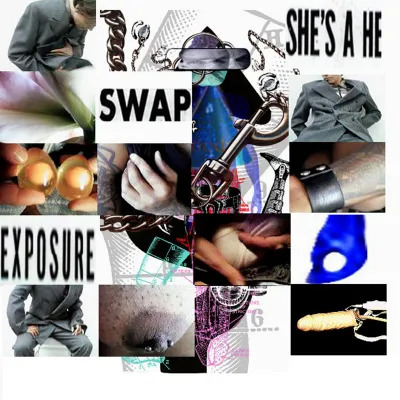
One of Cheang’s most beloved works no longer exists. Titled Kingdom of Piracy (2002), it took the form of a website designed as an open work space where artists could post their own creations for all to see. The idea was to make all this content available for free. It was sponsored by an art center run by Acer, one of the biggest tech companies in the world, based in Cheang’s home country of Taiwan.
Eventually Kingdom of Piracy became the victim of its own circumstances: The project was taken offline after a change in Taiwan’s piracy laws. “Well, that was a disaster!” Cheang says, looking back on it. Yet the outcome inadvertently proved her point: The piece was intimately related to the very place from which Cheang came, meaning that the same factors that shaped her identity also shaped her art.
Cheang started out making films when she was a teenager in Taiwan. “There was not really a cinema school,” she recalled, so she attended college for history and educated herself further by going to screenings of art house films held by European embassies. During the 1970s, she went on to receive formal education in cinema studies at New York University—though that was, in a way, an accident. “I didn’t apply to the right department,” she said, “but somehow I got in. It actually gave me a certain freedom.”
For about a decade, Cheang made a living working in commercial filmmaking as an editor. All the while, she experimented on her own with video, using the medium to confront the racism and homophobia that she encountered all around her. She produced segments about those topics for Paper Tiger Television, a nonprofit known for its DIY offerings, some of which were broadcast on public-access TV. But Cheang sought a more experimental mode, and she had clearly found it by 1990.
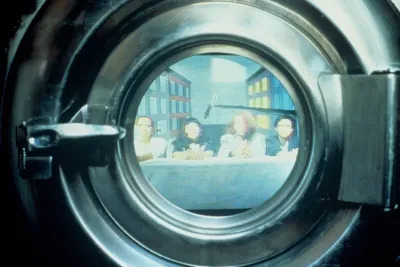
That was the year she exhibited the video installation Color Schemes at the Whitney Museum. For that work, Cheang filmed Asian American, African American, Latinx, and Native American actors recounting their experiences with racism, then played the footage on monitors situated inside washing machines. The unusual format was a play on the color-wash cycle, in which variously hued clothes are thrown together and laundered separately from the whites. Cheang returned to the Whitney three years later with another video installation at the 1993 Biennial, which was notoriously scorned by white critics because of its explicit emphases on race and sexuality.
Cheang’s first feature film, the 1994 Fresh Kill, seemed to signal a departure. Its protagonists are two lesbian parents—one is played by Sarita Choudhury, who has since ascended to global fame—who inhabit a polluted Staten Island clouded by a foreboding reddish fog. Their child is kidnapped, and they are lured into a tangled plot that involves the evil corporation responsible. Hacking becomes, for them, a primary means of defense.
I asked Cheang if Fresh Kill, which appeared in the film section of the 1995 Whitney Biennial after screening theatrically, spurred a turn toward science fiction in her art. She bristled against her art being categorized as such, as it commonly is, calling her work, starting with Color Schemes, an attempt to “modify reality.” But she conceded that her work started to “become more virtual” with Brandon, a landmark work of net art that debuted in 1998.

Brandon was based on the tragic tale of Brandon Teena, a trans man who was raped and murdered in 1993. Cheang, like many members of the queer community, was horrified by Teena’s story as much as she was drawn to it. She began reading up on Teena and ended up thinking about his life alongside “A Rape in Cyberspace,” a famed 1993 Village Voice story that described an online community rocked by virtual recreations of sexual violation.
Cheang spoke of a “fascination with building social space in the cyberspace” and said she wanted to do just that with Brandon. To make it, she traveled to Nebraska, to read through reams of court documents about Teena, and to Tijuana, where she accompanied a trans person seeking gender confirmation surgery. She also involved a range of collaborators, including artists Jordy Jones and Auriea Harvey, in the piece’s production.
What resulted was neither a journalistic investigation nor a biopic (the form taken by the 1999 film Boys Don’t Cry, whose director, Kimberly Peirce, spoke with Cheang during Brandon’s making). Brandon, which can still be accessed online, is a seemingly endless flow of web pages and pictures. Clicking some links may yield expected results—one pop-up opens a Google search for “Brandon Teena”—while others open portals that seem to have little to do with Teena, such as musings on Alan Turing’s queerness and a quotation from an interview with Venus Xtravaganza, a trans woman associated with the ballroom scene in New York. All the while, a scroll of images—some clickable, some not—fly by along an expanse of black lined with yellow dashes, a motif that recalls the highway near Teena’s Nebraska home.
Cheang was hardly the only one making sprawling works of net art like this one at the time, but Brandon has a vastly different feel from many contemporaneous pieces. “What I think is essential to understanding Brandon is that it wasn’t being made to look like a film, and it wasn’t being made to look like an artwork,” said John Hanhardt, the curator who commissioned the piece for the Guggenheim Museum, which recently restored it. “So much [net] art was static compositions for the screen and so forth. Hers is all about movement, changing point of view, identity confusion. That’s what made it so powerful.”
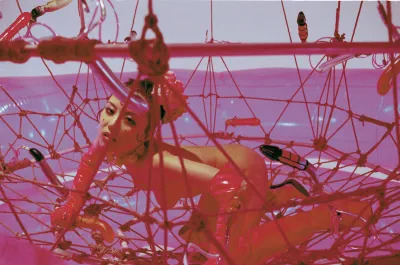
Cheang is one of the few artists ever to follow a major success with a pornographic flop. In 2000, at the Sundance Film Festival, she debuted I.K.U., a Blade Runner–like feature that was set 30 years in the future in New Tokyo, a city where a company is collecting data on cyborgian women’s orgasms. The film features unsimulated sex—no small amount of it, in fact, and not all of it heterosexual—which qualified I.K.U. as the first porno to play at Sundance. (There is a rich tradition of art house films incorporating real intercourse, but those works are not always sold as pornography. I.K.U., on the other hand, was marketed as “sci-fi porn,” and its title is a stylized version of the Japanese slang for “orgasm.”)
Even in Sundance’s permissive atmosphere, however, I.K.U. couldn’t find an audience. According to Cheang, many of its first spectators left before the screening ended. Although mainstream critics were unkind to the film, some scholars have sung its praises. B. Ruby Rich, the film scholar who sometimes been credited with coining the term New Queer Cinema, wrote that I.K.U. “frees the body from gender restrictions, empowers the object of fantasy, and merges the user and the used, the carrier and the carried, into a cyber-satyricon of impulses, stimulants, and gratifications.”
After the film’s failure at Sundance, he recalled that her distributor tried to comfort her, suggesting that I.K.U. might be received with more reverence later on. “I’m very used to people saying to me, ‘You are ahead of your time. This film is not sellable yet,’” Cheang said. She didn’t care. Seventeen years later, she made Fluidø, a sci-fi provocation focused on gender-fluid beings known as ZERO GENs whose semen-like fluids have narcotic properties. Fluidø was also sexually explicit, and it too caused walkouts when it premiered in Berlin. Not even queer film festivals in the United States wanted to screen it, according to Cheang.
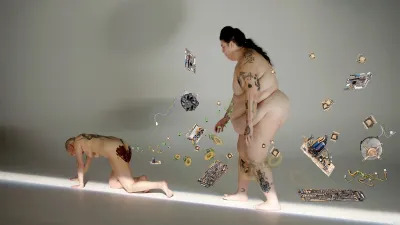
That has changed. I.K.U. and Fluidø, along with a new film, a new sequel to I.K.U. called UKI, all played in New York this summer at the Brooklyn Academy of Music, whose curator “didn’t even blink an eye,” Cheang says with a smile.
To some extent, this is because Cheang’s international reception has begun to change. In 2019 she was picked to do an exhibition for Taiwan at the Venice Biennale. (Taiwan is not recognized as a country by Italy, so it is ineligible for an official national pavilion at the world’s biggest art festival.) “It was the first time I didn’t need to raise any money for a production,” she noted—something that would have been inconceivable even a decade earlier.
Working with acclaimed scholar Paul B. Preciado, she developed 3x3x6, a sprawling video installation about the historical incarceration of queer people that also addressed contemporary forms of surveillance, with footage of people on city streets that a machine seemed to be analyzing. Visitors themselves were caught on camera, their faces scrutinized in real time by a machine that Cheang exhibited in an adjacent room in a translucent case.
When the show was on view, Cheang told an interviewer that she laid bare this surveillance mechanism because she wanted viewers to hack it. “By exposing the tools of governance,” she said, “we hope to incite discourse on the possibility of freedom amid omnipresent surveillance.”
A lot of Cheang’s work functions similarly. Take the case of UTTER, her “AI self-portrait.” In that work, the parameters are made visible to viewers, who can see what happens as this figure’s light skin is turned dark and its eyes are made to droop. That does more than just flaunt the technology that has gone into the piece—it also directs one’s attention to mechanisms within AI that are most often hidden.
I asked Cheang if, in making visible the secret architecture of technology, she aspires to free her AI self-portrait from its digital shackles. “In a certain way, to give a certain dignity, yes,” she said. “I think a lot of my work is about salvation or liberation.”
Immersive Art Is Exploding, and Museums Have a Choice to Make
Archaeologists Discover Ancient Human Remains in Pre-Incan Peruvian Temple Dedicated to Water Cult

Jeff Bezos May Be the Owner of a New $80 Million Gulfstream Jet

The 2024 U.S. Open: An Off-Court Guide to Fan Week and More

iPadOS 18: Features, beta, download, Apple Intelligence, release date, and more

NWSL Eliminates Draft, Boosts Pay as New CBA Overhauls League
